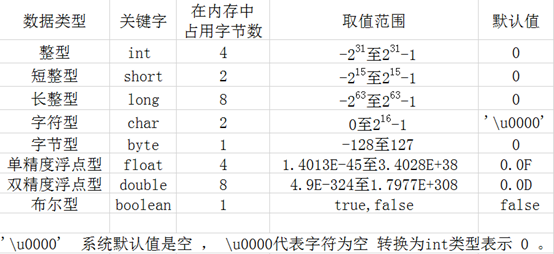We can use java program operation, we need to master data types, constants, variables and operators
About the data type I have summarized a Excel spreadsheet, the range in which the single-precision floating-point and double-precision floating-point calculation is not accurate.

Constants are running during the java fixed data, can be printed
public class Demo {
public static void main (String [] args) {
final int C =. 1; // create a constant, integer type, constant final keyword to define
System.out.println (C); // output: 1
}
}
Refers to the variable data can change during the java program is running, it can be printed
public class Variable {
public static void main (String [] args) {
int NUM = 50; // create a variable format: Data type variable name = data value
System.out.println (NUM); // Output: 50
int Number; // create a variable format: data type variable name;
Number = 3; // stored data into a variable: variable name = data value
System.out.println (Number); // output: 3.
Double d; // create a double-precision floating-point type of a variable, the variable name is named d
= 3.3 D; // stored data to a variable, the data value 3.3
System.out.println (D); // print output variable d, the output: 3.3
a float KK;
KK = 3.2F; // float which The default type is double, if we must use the float type, the need to add a suffix F.
System.out.println (KK); // output: 3.2
}
}
How to verify constant during the run java program fixed, variable can change?
public class the Test {
public static void main (String [] args) {
final int A =. 1; // create a constant, constants used to define the final keyword
System.out.println (A); // Output:. 1
final int 10 = b; // create a constant
// SB = "20"; // modify the values of the constants, will complain, can not run.
// workaround, delete or modify comments, because in doing exercises, so select the Notes to facilitate understanding during this review.
System.out.println (B); // Output: 10
int C = 100; //Create a variable assignment 100
C = 200; // modify a variable
System.out.println (C); // Output: 200
}
}
Operators are symbols constant and variable operating a equal sign operator is used in practice, the assignment operator.
Arithmetic:
public class Demo1 {
public static void main(String[] args) {
int a = 66;
int b = 66;
int r1 = a * b;
System.out.println(r1); //输出:4356,想要验算,可以使用手机or电脑上的计算器再计算一遍。
int r2 = a + b; //加法运算符
System.out.println(r2); //输出:132
int r3 = a - b; //减法运算符
System.out.println(r3); //输出:0
int r4 = a / b; //除法运算符
System.out.println(r4); //输出:1
int x =10;
int y =3;
int result = x%y; //模运算符
System.out.println(result); //10除以3,等于3余数1
}
}
逻辑运算符:
什么是逻辑?
简单打个比方,我们去超市购物,想要买一把雨伞
在收银台结算时,通常问默会自己,买没买雨伞。
这里的回答就是一种逻辑上的运算,买or没买。
是与否、有与无也都是逻辑的判断
public class Demo2{
public static void main(String[] args) {
boolean a = true;
boolean b = false;
System.out.println(a&&b); //输出:false。&&逻辑与运算符,仅当两个操作都为真,条件才为真。
System.out.println(a||b); //输出:true。逻辑或运算符,两个操作其中有一个为真,条件为真。
System.out.println(!a); //输出:false。逻辑非运算符,取反。
/* 这就是多行注释
* 与“&&”,或“||”,具有短路效果:
* 如果根据左边已经可以判断得到最终结果,那么右边的代码不再执行,从而节省一定的性能。
*
* 类比:斗地主时,我的牌是4和10,对方只有一张牌,我要如何出?
* 先出10,如果对方剩下的牌是5-10,那么我这局就赢了。
* 这在就是斗地主中,短路效果的应用。
*/
}
}
自增自减运算符
public class Demo3 {
public static void main(String[] args) {
int x = 1;
x++; //变量x自增1
System.out.println(x); //输出:2。因为变量x自增了1
int y = 1;
y--; //变量y自减1
System.out.println(y); //输出:0。因为变量y自减了1。
//自增自减符号,单独使用时,符号在前在后都一样。
//与其它混合使用时,如果,运算符在前,那么结果就要先增减,后打印。反之,符号在后,就先打印。
int a = 1; //运算符在前,那么结果就要先增减,后打印
System.out.println(++a); //输出:2。
int b = 1;
System.out.println(b--); //符号在后,就先打印,后自减。所以输出是1,输出后b的值自减1。
//如何看到b的值是否自减了呢? 将变量b打印输出即可
System.out.println(b); //自减之后变量b的值是0,所以输出:0
}
}